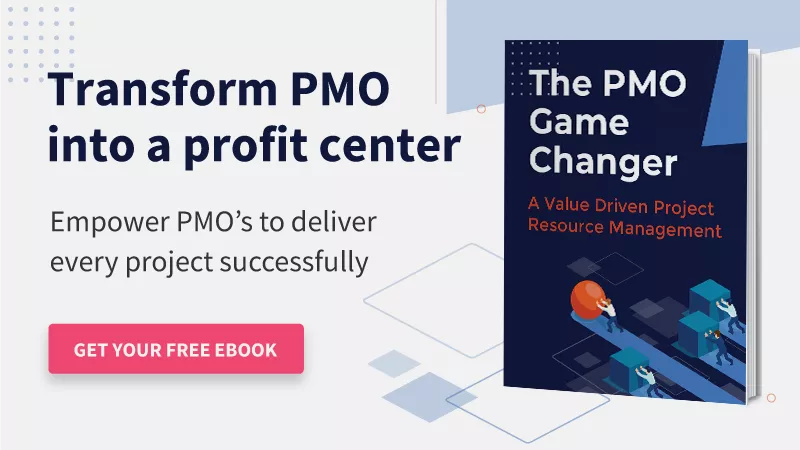Businesses have left behind the days of siloes of spreadsheets and legacy tools governing their management practices. With the advent of modern technology, they are now adopting intuitive solutions to scale-up their organizational efficiency. This adoption has contributed to the evolution of the administrative nature of a Project Management Office (PMO).
A PMO is no longer restricted to procuring management reports and setting business standards; it is now a value-center for a project-centric business.
From understanding the firm’s long-term strategic objectives to helping the managers achieve them by undertaking the right projects, PMO covers everything that impacts the bottom line.
Out of all these processes, documenting a project selection criteria is crucial. After all, the projects you take up decide the firm’s profitability and help you meet the business goals. This criterion is also one of the foremost steps in transforming the PMO structure from a cost into a profit center.

Here is a detailed description of the importance of developing a systematic criterion and its fundamentals.
Let’s begin with understanding the significance,
Significance of Project Selection
When you are running a project-based organization, every project that is taken up is a stepping stone towards attaining long-term goals. As mentioned earlier, a well-structured PMO is responsible for assessing and analyzing every project that comes their way before moving forward.
The question is, why is it so important to have a project selection criterion in place?
A project requires several resources (human and non-human), financials, a timeline, and other factors to become a reality. In return, businesses are rewarded with considerable profit and revenue and long-term clientele that improve overall profitability and help meet goals and build a reputation. However, not every project can align with your strategic point of view, and neither can each one of these prove to be profitable. Moreover, sometimes you don’t even have the right resource pool to do justice to the work.
In that case, you are investing your resources, their efforts, and your company’s finances in a futile area. Moreover, given the current market volatility, the resources are limited. If utilized in a wrong project, it will incur more loss, and other critical projects will suffer, showing a domino effect.
You can avoid these predicaments with a project selection method. When your firm and PMO follow some documented set of guidelines before accepting a project, they will evaluate every critical attribute keeping you from facing the loss.
Given the role of Project selection, let us now understand the fundamentals of the criterion vital to ensure successful project delivery,
The fundamentals of project selection criteria
Strategic Alignment with business goals
Every business has its own set of strategic goals, a defined vision, and a mission to project a clear path to success. That means every project you work on should help you climb up the ladder to achieve these strategic goals.
Thus, having a thorough understanding of your mission statement and examining the project to see if it aligns with these goals is the first and foremost step in project selection.
It will help you allocate your resources and their expertise to the right place. Moreover, it keeps you from wasting time and efforts on commitments that steer away from the organizational objective.
Read More: Project Resource Management: An Ultimate Guide on How to Master it
Assessment of resource capabilities and availability
Even though some projects might be the right fit for the firm and the future goals, you may not have the right personnel to accomplish them. Thus, the next important step towards ensuring a quality and successful project delivery is assessing the resource capability matrix. In addition to that, one must also keep a note of their bandwidth and availability in advance. Otherwise, they might end up over-utilizing the workforce, eventually causing burnout.
The PMO executives can equip a robust resource management tool to get a birds-eye view of the skills matrix and resource capacity in advance. With the ability to provide foresight into capacity vs. demand, resource utilization, and other metrics, a tool will empower them to make data-driven decisions. Once the assessment is done, they can take the call whether the project is feasible to continue with or not.
Read More: Understanding Resource Availability within Project Management
Evaluation of potential risks
Every project has its own set of risks and threats. The onus is on the project managers to decide if they can be mitigated or not. Once the project managers gauge their resource pool and give the go-ahead, the next step is to evaluate the potential risks they might face diligently.
A prior risk assessment helps you first understand if it’s a high-risk or low-risk project based on your pre-set risk appetite. In case it’s a low-risk project, managers can even form a contingency plan well ahead of the curve to prevent future bottlenecks. Implementing an intuitive tool will ease the process of risk management as it will help you simulate various project constraints and carefully assess the result of variables.
The impact on customer satisfaction and brand loyalty
Maintaining the competitive edge and staying relevant during the ongoing market uncertainties is of utmost importance for a firm. That is only possible when your clients are happy with you and stay with you in the long haul. Thus, the next fundamental in the criteria is to study the impact of your project on customer satisfaction and brand loyalty.
The questions that need to be addressed are:
- How will the final output of the project solve the existing problems for the client?
- Will the project improve the client’s perception of your firm’s products and services?
Once your PMO team reaches a consensus and believes the project can enhance customer satisfaction and improve your brand loyalty, you will be in the right position to take up the project.
Read More: The PMO Game Changer: A Value-Driven Project Resource Management
Data Availability and Expected Revenue
Last but not least, finding out if you have enough data available on the project and, if not, is it possible to collect data from varied sources is imperative. When you are working on a project and the essential data in place, implementing it at the right place and the task becomes a breeze. Or else, your resources will have to spend countless hours gathering the right information, analyzing it, and then implementing it. In worse situations, limited data availability can become a potential roadblock in a project’s progress.
Along with this, calculating the ROI (Return on Investment) or the approximate revenue the project will generate is crucial. Because, of course, you do not want to use your resources, skills, time and effort, and your company’s finances on a low-revenue generating project. It will not only lower your profitability but also keep you from taking up a higher revenue-generating project. Managers follow a benefit-evaluation model to calculate this. It is discussed in the later sections in detail.
These are the fundamentals you must keep in mind while developing a systematic project-selection criterion.
Read More: How to Manage Resources in Agile Project Management?
Here is a brief description of the two project selection models used widely by the PMOs:
The Selection Models Used by PMO
Benefits Measurement
As the name suggests, this model calculates the anticipated revenue that can be the net profit that the firm can generate after deducting the capital expenditure and taxes. In simple words, it calculates the worth-creation of the firm while detailing the return on capital.
- Payback Period
It is a basic selection model that gives you the time a project will require to return the investments. The projects that have a lower payback period are taken over those with a higher payback period.
- Scoring Model
The scoring model is an objective selection method. The PMO executives consider every relevant criterion and score them. The value written against each is then cumulatively added to rate the project. The one with the highest score is chosen.
- Opportunity Costs
The opportunity cost model tells you about what you will lose if you give up a certain project. In this case, the project with the lowest opportunity costs is taken up.
- Discounted Cash Flow
This model evaluates the future value of money against the current one. Of course, USD 2000$ won’t worth the same in the future. It is a critical factor that should be given due importance while selecting a project.
- Net Present Value (NPV)
It is the difference between the current cash inflow and the potential outflow of a project. The only difference between the payback period and NPV is that it considers the discounted cash flow rate, enhancing its accuracy. Note that NPV must be positive for the projects you plan to accept.
- Internal Rate of Return
The internal rate of return tells you the interest rate at which the NPV becomes zero. It basically means when the inflow and outflow of the project are equal. You will get an idea of project profitability based on the IRR value.
Read More: 5 Top Project Metrics You Need to Use Today
Let us now look at the next selection model,
Constrained Optimization
Constrained optimization, also known as the Mathematical Model of Project Selection, is used for complex projects that require multiple, complex calculations.
Here are the techniques used in this model:
- Linear Programming
This method is essentially used to reduce project costs by efficiently reducing the project duration without affecting the quality.
- Integer Programming
Integer programming is similar to linear programming except for the fact that it considers the integer value of the constraints rather than the fractional ones.
- Dynamic Programming
Dynamic programming lets you subdivide the complex project problem into smaller chunks. Based on the nature of each of these, you can select a different optimization technique, thus the name dynamic programming.
- Multiple Objective Programming
Often a solution to one problem can degrade the value of the other one. For example, in a fight to reduce project costs, the quality of the project might suffer. In such conflicts, multiple objective programming is applied. It means a problem can have multiple optimal solutions, and the ones that do not deteriorate the other factor are selected.
Read More: 5 ways to Reduce Project Management Costs
These are two quantitative models used for project selection and optimization.
Conclusion
As mentioned above, the project selection criterion plays a significant role in deciding your profitability and success rate.
If the PMO agrees to a non-profitable project or a misaligned one from your goals, it will lower your competitive edge, and worse, may put a question on your sustainability in the long run.
Thus, it is of utmost importance to formulate well-structured project selection criteria to ensure you are working on profitable and value-adding projects. The fundamentals mentioned above will help you get the selection criteria right and ensure profitability in the long run.
Have you followed any additional criteria to select the right projects?
The SAVIOM Solution
SAVIOM is the market leader in providing an Enterprise Resource Capacity Planning solution. With over 20 years of experience leading the market, Saviom is actively used by over 15 highly-esteemed global companies worldwide. The tools within the suite include project portfolio management, professional service automation, and workforce planning software. Re-engineer operational efficiency with a system shaped around your business!











